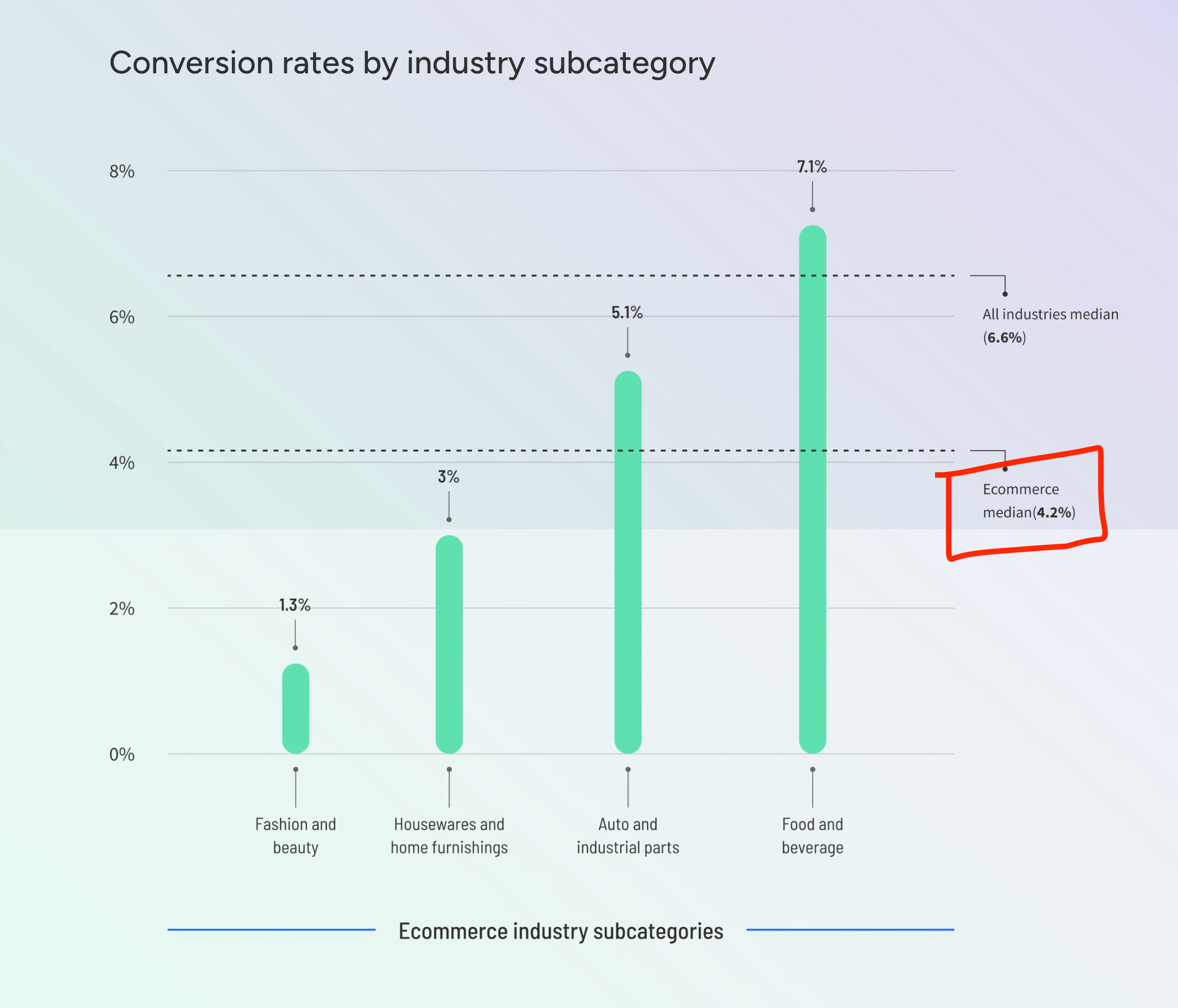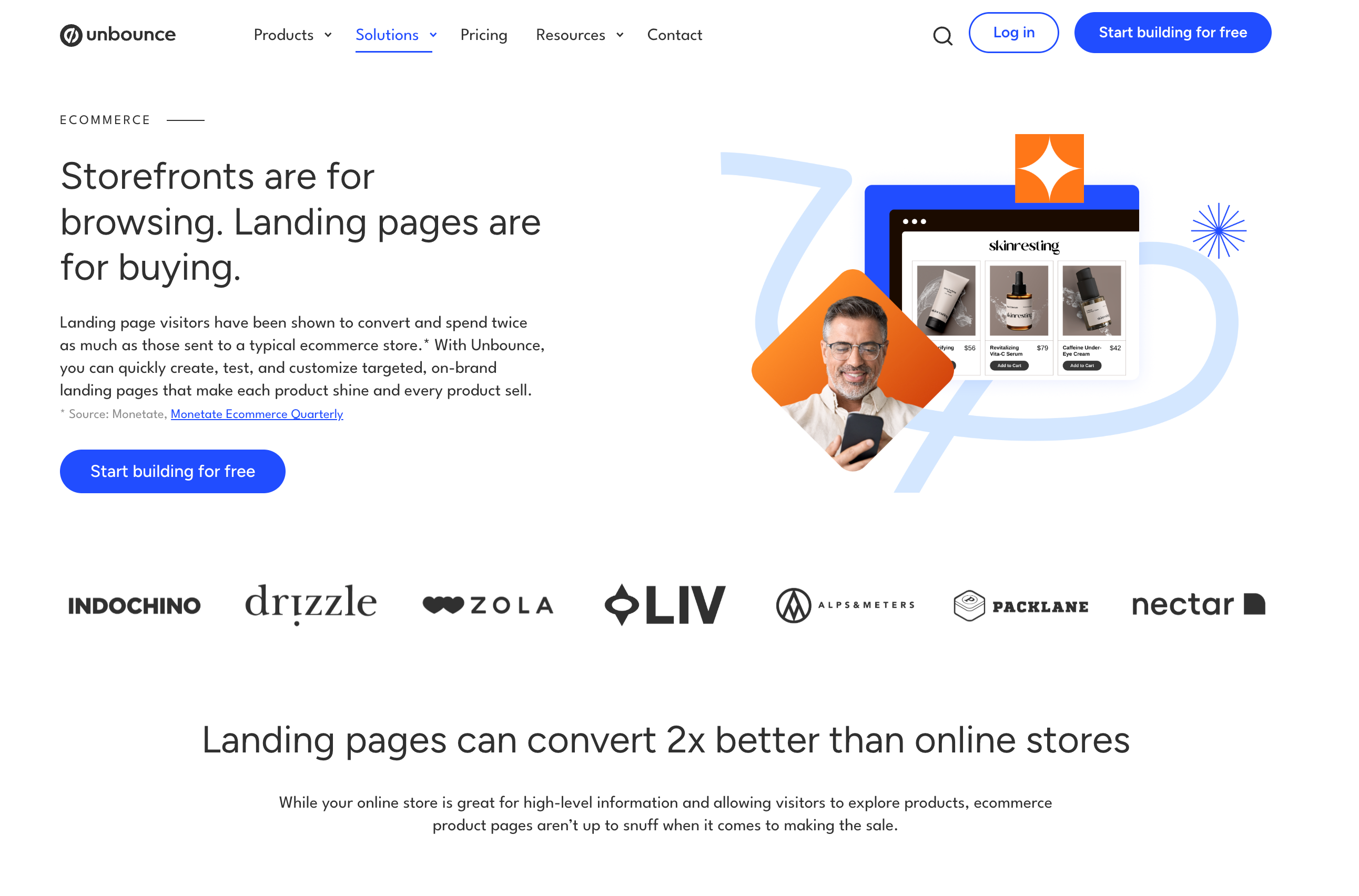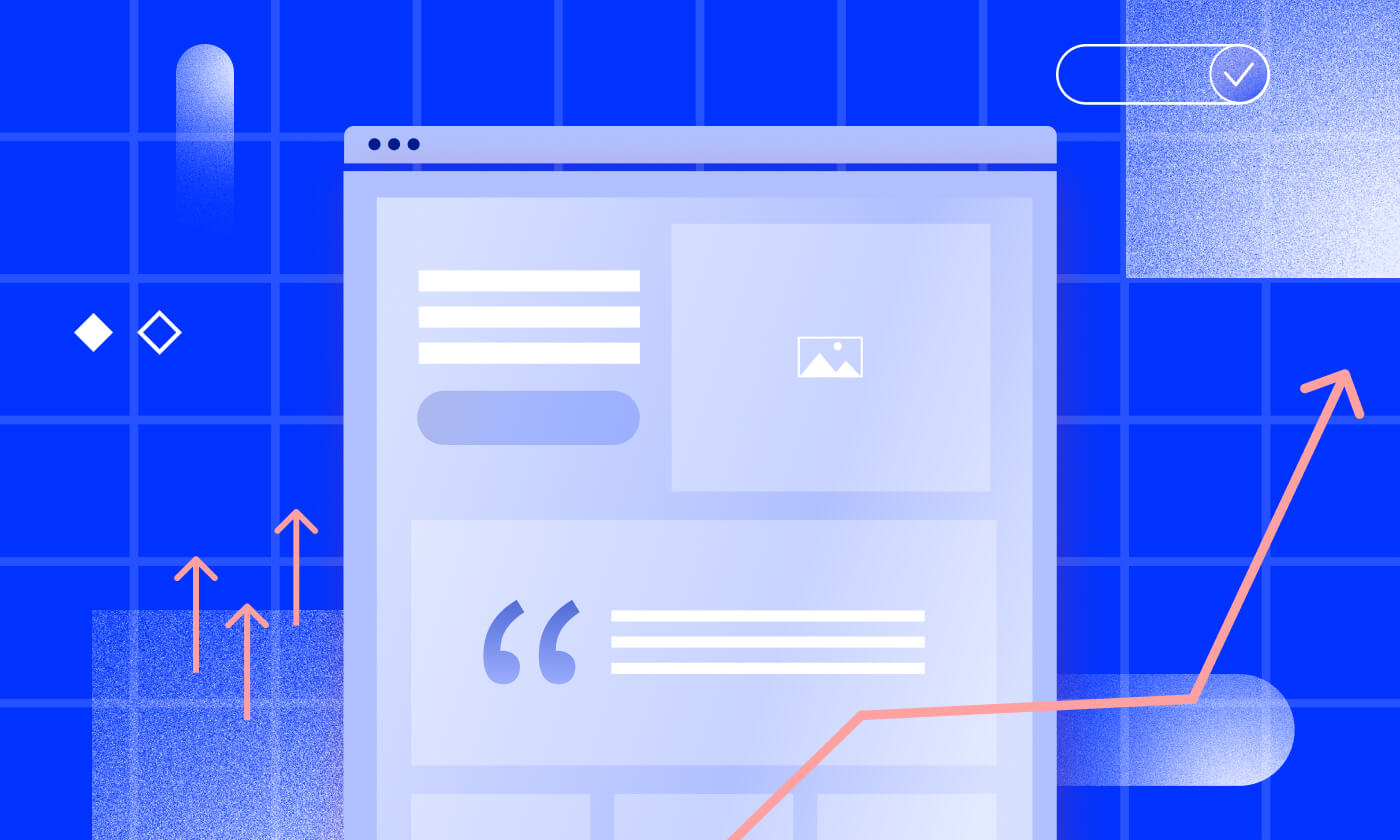Think of it this way: What if you could move your metrics in all the right directions without increasing your marketing budget?
Or, better yet, what if hitting your conversion benchmarks didn’t mean endlessly scratching and clawing to bring in more and more traffic?
Best of all: What if you were able to transform yourself from the marketer who’s always asking for more ad spend, into the savvy digital strategist who knows how to get more ROI out of less dollars spent?
We know there’s a lot of noise online about conversion rate optimization, so it’s natural to be skeptical. We get it. But the truth is CRO is as real and honest a friend you can have in the game of digital marketing.
When done right, conversation rate optimization for ecommerce makes it easier for marketers to hit their conversion benchmarks by turning more of the traffic they’re already getting into paying customers. That’s every marketer’s dream, right?
So if you’re wondering how you can start putting CRO best practices to work for you and your team, you’re in the right place.
In this article, we’ll take a deep dive into the ABCs of conversion rate optimization for ecommerce—from what it is in theory, to what it looks like in practice.
Let’s dive in.
What is ecommerce conversion rate optimization?
Before getting into CRO best practices it’s helpful to understand (or get a quick refresher on) a few basic terms and concepts, so let’s start there.
If this feels a bit too much like Marketing 101, feel free to skip down to where we provide some top tips you can use to improve conversion rate optimization for your site.
Alan O’Sullivan
Alan is a content strategist and writer who works at the intersection of business needs and people needs, which is a fancy schmancy way of saying his goal is to make everyone happy most of the time. His passions include pushing back against the notion that nobody reads and annoying his kids with very bad jokes about broccoli.
» More blog posts by Alan O’Sullivan
Defining “conversions” in ecommerce
Every website has actions it wants its visitors to take, which are generally known as conversions. For some websites, the desired conversions might be actions like downloading a white paper or filling out a form.
For ecommerce sites, conversions are ultimately about selling products. While the primary conversion point in ecomm is when a sale is made, it’s not the only one. Other actions might include things like:
- Adding an item to a wishlist
- Adding an item to a cart
- Signing up for a newsletter
Tracking and understanding conversions is important because they help you identify which steps in a user’s journey are working and which ones aren’t. For example, if your conversion rate for “visitors who add a product to their cart” is solid, but your conversion rate for “users who successfully check out” is so bad it’s all anyone can talk about on the team Slack channel, then there might be a problem in your checkout flow.
Ecommerce conversion rate optimization (CRO)
There are no big surprises here. As the name suggests, conversion rate optimization is all about getting more of your existing visitors to complete desired actions. For ecommerce sites, that ultimately means turning a bigger percentage of traffic into paying customers.
At a nuts and bolts level, ecommerce CRO is a set of practices that can include things like A/B testing, qualitative user testing, user journey mapping, and more. Really, it’s about putting on your detective hat (which doesn’t have to look like a Sherlock Holmes deerstalker, but hey, why not?) to get a better understanding of what’s driving, persuading, and preventing your customers from taking action.
How to calculate ecommerce conversion rate
Calculating conversion rates is simple. You take the total number of conversions, divide that number by the total number of visitors, and multiply by 100 to get a percentage:
(Conversions) ➗ (Visitors) x 100 = Conversion Rate
So if you had 100 conversions and 5,000 visitors in a set time period, your conversion rate would be 2% (100 divided by 5,000, then multiplied by 100) for that time period.
But hold up—before you bust out your calculator, a word of warning: As simple as this formula is, it’s also easy to make simple mistakes that’ll skew your data if you’re not comparing apples to apples and oranges to oranges.
For example, let’s say you want to calculate the conversion rate for a specific product listed on a specific page being added to the shopping cart. In this scenario, you need to make sure you’re only including visitors to that specific page (and within the same time period) in your calculation, as opposed to the total number of visitors across your site (including other pages) who added that product to their cart. This might seem like an obvious callout but mistakes like this are easy to make and can throw off your CRO efforts before you even get started.
Why is ecommerce conversion rate optimization important?
There are only a handful of digital marketing levers you can pull if you want to systematically increase your ROI in ecommerce.
The one that always attracts the most attention is the goal of driving more traffic to your site through tactics like paid advertising, influencer campaigns on social media, and SEO. There’s absolutely nothing wrong with these, or with the goal of driving more traffic to your site, but they can become costly, increasingly competitive, and even reach a point of diminishing returns.
The other big lever you can pull is the goal of improving conversion rates on the traffic you’re already receiving. Where tactics like SEO focus on bringing more people to your digital storefront, CRO is focused on getting more of them to browse through your store (i.e. spend some time on your page) and eventually whip out their credit card or pop in their contact details.
Put another way: Successful conversation rate optimization in ecommerce means increasing sales without increasing your marketing budget.
It’s important to note that, while increasing sales is the ultimate goal in ecommerce, it’s not the only reason why CRO is so valuable. Since the practice of conversion rate optimization is so inherently focused on improving user experiences, sites that nail it also tend to enjoy perks like:
- Lower bounce rates
- Lower cart abandonment rates
- Improved customer retention rates
- Enhanced customer trust and loyalty
- A more nuanced understanding of their customer’s needs
What’s a good ecommerce conversion rate?
So, what ecommerce conversion rate should you be shooting for?
High-five-worthy conversion rates are different for every industry, and even within industries you can see a huge amount of variance. For instance, across ecommerce as a whole we’ve found a median conversion rate of 4.2%.
You can dive deeper into the data and find the typical conversion rate for your ecommerce niche in our Conversion Benchmark Report, which also includes insights on proven CRO tactics that are working best in each industry.
Setting your own ecommerce conversion rate goals
Industry benchmarks aren’t the be-all and end-all of finding conversion rate success. You might not be where the rest of your industry is right now—or even later—and that’s ok. The key word to focus on in “conversion rate optimization” is the last one: optimization.
What matters most—especially if you’re just starting your CRO journey—is setting goals that are realistic, reasonable, and attainable. Your goal is to make steady improvements. Remember, even small increases in conversion rate can result in big revenue gains over time.
10 ecommerce CRO best practices (AKA how to boost ecommerce conversion rates)
Now that you understand what ecommerce CRO is and why it matters, let’s get to the good stuff—the actual tactics that move the needle.
We’ve compiled these best practices from years of testing and optimization across thousands of online stores. No theoretical fluff here—just practical steps you can start implementing today to see real results.
1. Create streamlined landing pages
Landing pages should be designed with the intention of driving each visitor to a single goal. Not several goals, not primary goals and secondary goals—just one goal. Well-designed ecommerce landing pages with a single focus—such as selling the benefits of a single product or service—have a much higher chance of conversion than pages with competing calls-to-action or links that take them further away from making a purchase decision. Unbounce tools like Smart Builder make it easy to create streamlined, optimized, and focused landing pages that convert.
Tip: Only include a single call-to-action on the page, or multiple calls-to-action that all lead to the same destination. You can also find the step-by-step process to create a landing page here.
2. Follow clear and uncluttered UX principles
Most people browsing the web today are like a child working on a class project—they’re task-oriented but have ultra-short attention spans. Ecommerce shoppers are no different. Clear and uncluttered UX designs make it easier for them to find exactly what they’re looking for in an online store. If they have to navigate through too many visual distractions, confusing interaction design, poor information architecture, or inconsistent terminology, their visit likely won’t last long.
Tip: Focus first on simplifying navigation, clarifying category labels, and ensuring your site search is effective. Those are three big factors in keeping visitors on your site and encouraging them to explore more, rather than bouncing in frustration.
Follow these conversion focused design principles to elevate your user experience and keep visitors engaged on your landing page.
3. Add trust signals and social proof
How you describe your own product or service will always pale in comparison to the first-hand experience of other paying customers. Those opinions don’t always have to be glowing, either. Even a large amount of average reviews is a highly useful trust signal that your ecommerce store is active and making sales.
Tip: If you haven’t already, add social signals like customer reviews and star ratings to your product pages. You can also automate post-purchase follow-up emails to encourage customers to submit a review about their recent purchase, which will help you attract more reviews.
Ready to witness a conversion boost? Explore these tips on leveraging social proof effectively for maximum business success.
4. Optimize for mobile devices
Bottom line: If your digital store isn’t mobile friendly, anyone not on a laptop or desktop is probably bouncing and heading to the next search result in Google.
Tip: Don’t just optimize your ecommerce store to be mobile-friendly. Design it for mobile from the very start, and make sure it looks good on any size screen.
Ready to create a seamless mobile experience for your audience? Check out these mobile-friendly landing page examples for inspiration and turn clicks into conversions!
5. Simplify the checkout process
Checking out on an ecommerce site in 2023 should be simple, fast, and flexible. Here are a few simple rules of thumb to keep in mind as you’re putting your checkout experience under the microscope:
- Reduce the number of steps
- Provide a range of payment options
- Give visitors the option to check out as a guest—without creating an account
In short, customers shouldn’t have to jump through hoops to make a purchase. If you want to increase your ecommerce conversion rates, simplifying your checkout process is a must. (We have a few useful tips to make your checkout process so smooth it’ll make butter jealous.)
Tip: If you’re not sure where to start, try a few rounds of live user testing on your current checkout experience. This will give you valuable qualitative insights into what customers like, don’t like, and are unsure about during the checkout process.
6. Use short, simple messaging
The goal of your store’s copy should be to answer questions and inspire action. The best way to do that is to keep all of your messaging short, simple, and authentic. That means prioritizing functionality over creativity, and brevity over wordiness. It also means cutting out hyperbole and overly promotional clichés. If you can do this, your customers will have an easier time finding the things they want on your site.
Tip: Aim for a grade 6 reading level in your website copy. You can check this yourself using tools like Hemingway Editor. Also, avoid words that aren’t typically spoken aloud in casual conversation. Try reading your copy out loud—if any of it sounds stilted or awkward take another pass at it. (You can also use AI tools, like Smart Copy.)
7. Don’t just track metrics—test, test, test
Deliberately testing the changes you’re making helps you discover what works in a methodical way. Instead of trying a few things and seeing how your overall conversion rate changes, you’ll find more success if you conduct specific A/B tests and measure those results incrementally.
For example, if you want to increase clicks on a landing page, start by testing one small change first, such as the headline or CTA copy, rather than rewriting the entire page. The goal of testing is to pinpoint areas of improvement with precision.
Tip: A/B testing isn’t perfect and has some drawbacks: It can be slow, requires a lot of effort, and needs a lot of traffic to increase accuracy. Thankfully there are tools like Smart Traffic, which streamlines testing by assessing visitor attributes and automatically sending traffic to the pages where they’re most likely to convert.
8. Offer personalized recommendations
Do you prefer when someone talks to you, or just speaks in your general direction? We’re guessing the former, especially when you’re trying to get more information to decide if you want to buy something.
That’s why tailoring the shopping experience to individual preferences can significantly enhance user engagement and increase sales. If your team’s capabilities and tech stack are up to the task (we know, easier said than done) you can use data analytics and AI to provide personalized product recommendations to customers, based on their browsing history and past purchases. This is a pretty advanced move so make sure you’ve got good relationships with the devs and engineers on your team (free coffees and treats might help) if you’re trying to get something like this implemented.
Tip: The sky is the limit for what you can do with personalization, but if you’re just getting started then keep it simple. For instance, adding “Products you might like” to various pages of your site—including product pages—is a solid first step.
9. Ensure your messaging matches across experiences
Consistency in messaging across all channels—your website, social media, email campaigns, and any other digital touchpoints—is crucial. This not only helps maintain your brand standards but also improves the overall user experience.
By aligning the words and phrases used in different touchpoints you’re minimizing the potential for confusion or uncertainty. For instance, if your social media promos are hyping up your holiday sale by telling everyone to enter promo code “HoHoHo” during checkout, you better make sure that input field in your checkout is clearly labelled and easy to find.
Tip: If you don’t know where to start, begin by auditing the cross-channel user journeys or campaigns that bring in the highest amounts of traffic. Review them regularly to ensure the messaging at each touchpoint is consistent and aligned.
10. Reduce loading times
Website speed is a critical factor, not only for user experience but also for search engine rankings. A slow-loading website can increase bounce rates and significantly lower conversion rates, not to mention downgrading your ranking on search results.
There are a lot of different and useful technical tactics that can be used to reduce a website’s loading times. Some of them will require close collaboration with your tech teams, including engineers and developers.
Tip: Use tools like Google PageSpeed Insights to analyze your website’s performance and provide recommendations to improve load times.
It’s not all about tactics. Having the right tools for the job makes a big difference as well. These are a few of our favorites—and yep, we’re adding some of our own to the list because they work great and, well, we kinda like ‘em (and we think you will too!).
4 ecommerce conversion rate optimization tools
It’s not all about tactics. Having the right tools for the job makes a big difference as well. These are a few of our favorites—and yep, we’re adding some of our own to the list because they work great and, well, we kinda like ‘em (and we think you will too!).
Unbounce
We might be a little biased here (okay, a lot biased), but we think Unbounce is pretty great for ecommerce marketers looking to boost their conversion rates.
Most online stores make the mistake of sending all their traffic to the same handful of pages. With our platform, you can create an unlimited number of targeted landing pages for different campaigns, products, or audience segments without breaking a sweat.
Our drag-and-drop builder makes it ridiculously easy to build high-converting pages—no coding required. Just grab elements, place them where you want, and customize everything from colors to fonts to images.
Want to test if green buttons convert better than blue ones? Or if “Shop Now” outperforms “Get Started”? We’ve got you. Our A/B testing tools let you run experiments without any technical headaches, automatically dividing your traffic and showing you which version wins.
The best part? Our library of 200+ high-converting templates gives you a massive head start. These aren’t just pretty designs—they’re battle-tested conversion machines built on real data. Pick one that matches your product category, swap in your content, and you’re ready to go.
Start small and scale up as you learn what works. Test one element at a time, apply what you discover, and watch your conversion rates climb month after month.
Hotjar
Image courtesy of Hotjar.
Hotjar is an uber-popular tool for UX designers and researchers, and for good reason. It includes a bunch of cool tools that help you get more insights into the behavior of our site visitors. This includes things like heat maps, visitor recordings, and conversion funnels.
Basically, Hotjar helps you understand how users interact with your site—where they’re running into roadblocks, what’s causing them confusion, and so on. This can reveal pain points and areas for improvement, such as which parts of a page are getting the most attention (yay!) and where visitors are dropping off (boo!).
Microsoft Clarity
Image courtesy of Microsoft Clarity
Like Hotjar, Microsoft Clarity is a tool for analyzing user behavior through features like heatmaps and session recordings. Clarity doesn’t offer the full suite of tools that Hotjar provides—for instance, it only integrates with Google Analytics whereas Hotjar works with over 1,000 other services via Zapier—but it does offer more features in its free plan than you’ll see in Hotjar’s free plan.
Google Analytics
Image courtesy of Google Analytics
Ah, Google Analytics. If you’re a marketer, you should never leave home without it. This staple of digital marketing toolkits lets you track everything about your website traffic and user behavior, including conversions. If you’re creating a structured plan around conversion rate optimization, ensuring you’re tracking the right metrics in Google Analytics is critical.
3 great examples of ecommerce conversion rate optimization in the wild
Tips and tools are great, but the proof is in the pudding. What does CRO look like in practice? Now that you know what to look for, you’ll probably start noticing things that work well and things that don’t as you browse the web yourself.
Here are a few examples of ecommerce sites that are nailing CRO best practices.
1. Allbirds
Image courtesy of Allbirds
Allbirds is an online clothing and shoes retailer that’s all about sustainability and being eco-conscious. Their site features a user-friendly design, high-quality photography, and playful headlines that encourage visitors to get outside and get moving.
From a CRO perspective, product pages are where the Allbirds experience really shines. In addition to high-quality photos and detailed product descriptions, each page also includes useful information on how to care for the product after you’ve bought it, as well as an explanation about how it was made with sustainable materials. These are small details that can help build trust with potential customers, especially those who connect with Allbirds’ sustainability values.
To top it off, customer reviews on each Allbirds product page can be filtered by categories like size, fit, activity level, and more. This makes it possible to see reviews that aren’t just relevant to that product, but also to your exact needs with that product.
CRO tactics that stand out:
- Clean and uncluttered UX
- Detailed product description pages
- Short and simple messaging that gets the message across fast
- Robust, filterable review system on every product page
2. Bellroy
Image courtesy of Bellroy
Bellroy is another ecommerce platform with a strong commitment to sustainability. How strong? Its “About us” section—which includes pages about its story, sustainable materials, and commitment to responsible business—is embedded right in the top navigation menu alongside its product categories. If you’re a shopper who also values sustainable products and businesses, this deliberate decision to put Bellroy’s sustainability values on equal footing with its product catalog is a strong hook.
The site has a fairly typical design for an ecommerce store but some subtle details stand out. For instance, it has a clean and simple navigation with clear product category labels that are also accompanied by product images. Not sure what a key holder is? Or a sling? The images in the navigation give you that little bit of extra context to help you find your way faster.
When you land on a Bellroy product page, you’ll quickly get a sense of whether the item is what you’re looking for thanks to short and to-the-point descriptions, accompanied by shorter and even-more-to-the-point bullets. Remember, attention spans online are short. Bellroy product pages are easy to scan so shoppers can get the info they need in seconds.
CRO tactics that stand out:
- Simple and clear navigation
- Images in the product hierarchy for enhanced wayfinding
- Streamlined product description pages
3. HelloFresh
Image courtesy of HelloFresh
HelloFresh is a meal kit subscription service that aims to “take the stress out of mealtime.” It also takes the stress out of finding a meal kit subscription service, as its homepage works well as a simple, clean, informative, and compelling landing page from top to bottom.
HelloFresh’s page blends mouthwatering imagery with clear messaging and only a handful of CTAs—all of them aimed at moving visitors a little further down the purchasing funnel.
While most ecommerce sites have homepages that surface a broad array of products and categories, HelloFresh’s approach is more about educating visitors about how it works and what kind of meals are available. It even has an FAQ section—when was the last time you saw a digital storefront with one of those?
CRO tactics that stand out:
- Clear focus on answering shoppers’ questions
- Transparency into how the service works
- Social proof on the homepage



![[Build – TOFU – Ecommerce] Landing Page Lookbook – V2](https://unbounce.com/photos/LookBook-Blog-Visual-CTA_1.png)







![[Build – MOFU] Landing Page Templates – V1 – 2024 landing page templates](https://unbounce.com/photos/blog-visual-cta-2x-v2.jpg)






